
Introduction
Nestled on the stunning coastline of the Mediterranean Sea, Marseille beckons visitors with its vibrant atmosphere, rich cultural heritage, and breathtaking natural beauty. As France’s oldest city, Marseille boasts a storied past that dates back over 2,600 years, making it one of the country’s most historically significant and diverse destinations. With its bustling ports, charming old town, and diverse neighbourhoods, Marseille offers a captivating blend of ancient traditions and modern influences that create a unique and dynamic atmosphere.
From its iconic Vieux Port (Old Port) to its bustling markets, historic landmarks, and picturesque Calanques, Marseille offers a wealth of attractions and activities to suit every traveller’s interests. Whether exploring the city’s maritime history at the Museum of European and Mediterranean Civilisations (MUCEM), wandering through the colourful streets of Le Panier district, or soaking up the sun on the beaches of Prado or Catalans, Marseille promises an unforgettable experience filled with culture, adventure, and Mediterranean charm. As a gateway to the Provence region and the French Riviera, Marseille invites visitors to discover its rich cultural tapestry, savour its delectable cuisine, and immerse themselves in the vibrant rhythms of southern France.
Table of Contents
Map of the Best Things to Do in Marseille
Old Port (Vieux Port)

The Old Port, or Vieux Port, stands as the beating heart of Marseille, tracing its roots back to ancient Greek and Roman times when it served as a bustling commercial hub. Over the centuries, it has evolved into a picturesque waterfront area lined with colourful buildings, lively cafes, and bustling markets. One of the best ways to experience the Old Port is by taking a stroll along its quays, where you can admire the boats and yachts bobbing in the harbour and soaking in the vibrant atmosphere. Be sure to visit the Fish Market, known as the Vieux Port Fish Market, where you can sample fresh seafood and watch fishermen unload their daily catch.
For those seeking adventure, boat trips and ferry rides depart regularly from the Old Port, offering the opportunity to explore the scenic coastline and nearby islands such as the Frioul archipelago and Château d’If. Additionally, the Old Port hosts various events and festivals throughout the year, including the famous biennial maritime festival, attracting locals and visitors alike. To make the most of your visit to the Old Port, consider grabbing a seat at one of the waterfront restaurants or cafes, where you can enjoy panoramic views of the harbour while savouring traditional Provençal cuisine and sipping on a glass of pastis, a local anise-flavoured liqueur.
Marseille History Museum

The Marseille History Museum, situated in the heart of the city’s historic Panier district, offers a captivating journey through the rich tapestry of Marseille’s past. Housed within the 17th-century Maison Diamantée, the museum’s collection spans millennia, from ancient Greek and Roman artefacts to artefacts from the medieval and modern eras. Visitors can explore exhibits showcasing Marseille’s maritime heritage, its role as a crossroads of cultures, and its evolution into the vibrant metropolis it is today. Practical tip: The museum is easily accessible by public transportation, with several bus and metro stops nearby, and is within walking distance from other attractions in the Old Port area.
For a deeper understanding of Marseille’s history and culture, consider joining one of the museum’s guided tours or workshops, which provide insights into specific aspects of the city’s past. The museum also regularly hosts temporary exhibitions, highlighting different aspects of Marseille’s history and heritage. Before visiting, it’s advisable to check the museum’s website for the latest information on opening hours, special exhibitions, and any COVID-19-related safety measures.
Le Panier Quarter

Le Panier quarter, nestled within Marseille’s historic centre, is a charming labyrinth of narrow streets, colourful facades, and hidden squares that exude an undeniable old-world charm. This ancient neighbourhood, dating back over 2,600 years, is Marseille’s oldest district and a testament to the city’s rich history and diverse cultural influences. Originally founded by the Greeks in the 6th century BC as the settlement of Massalia, Le Panier has seen the rise and fall of empires, including the Romans, Visigoths, and Moors, each leaving their mark on its architecture and culture. Practical tip: Exploring Le Panier on foot is the best way to soak in its ambience and discover its hidden treasures, but be prepared for steep cobblestone streets and uneven pathways.
Le Panier is not only a delight for history buffs but also a haven for art lovers and food enthusiasts. Wander through its winding alleys to discover vibrant street art murals, boutique galleries showcasing local artists, and quaint cafes serving up traditional Provençal cuisine. Don’t miss the Vieille Charité, a former almshouse turned cultural centre, which houses museums and exhibitions dedicated to Mediterranean archaeology and contemporary art. Additionally, Le Panier is home to numerous artisan workshops, where you can watch craftsmen at work and purchase unique handmade souvenirs.
Marseille Cathedral

Marseille Cathedral, officially known as Cathédrale Sainte-Marie-Majeure de Marseille or simply La Major, is an architectural marvel and one of the city’s most iconic landmarks. Built in the 19th century on the site of a former 12th-century church, La Major is renowned for its stunning Byzantine-Romanesque architecture, characterized by its massive domes, intricate facades, and ornate interiors. The cathedral’s construction spanned over several decades, with contributions from various architects, including Léon Vaudoyer and Henri-Jacques Espérandieu, resulting in a magnificent blend of styles. Practical tip: Visitors should dress modestly when visiting Marseille Cathedral, as it is still an active place of worship, and remember to check the opening hours for guided tours and religious services.
Stepping inside Marseille Cathedral is like entering a grand sanctuary of serenity and spirituality. The cavernous interior is adorned with exquisite marble columns, intricate mosaics, and breathtaking stained glass windows, creating an atmosphere of awe and reverence. Be sure to marvel at the cathedral’s magnificent organ, one of the largest in France, and attend a choir performance or organ recital for a truly immersive experience. Additionally, don’t miss the opportunity to climb to the rooftop terrace for panoramic views of Marseille’s Old Port and the Mediterranean Sea.
Museum of European and Mediterranean Civilizations (MuCEM)
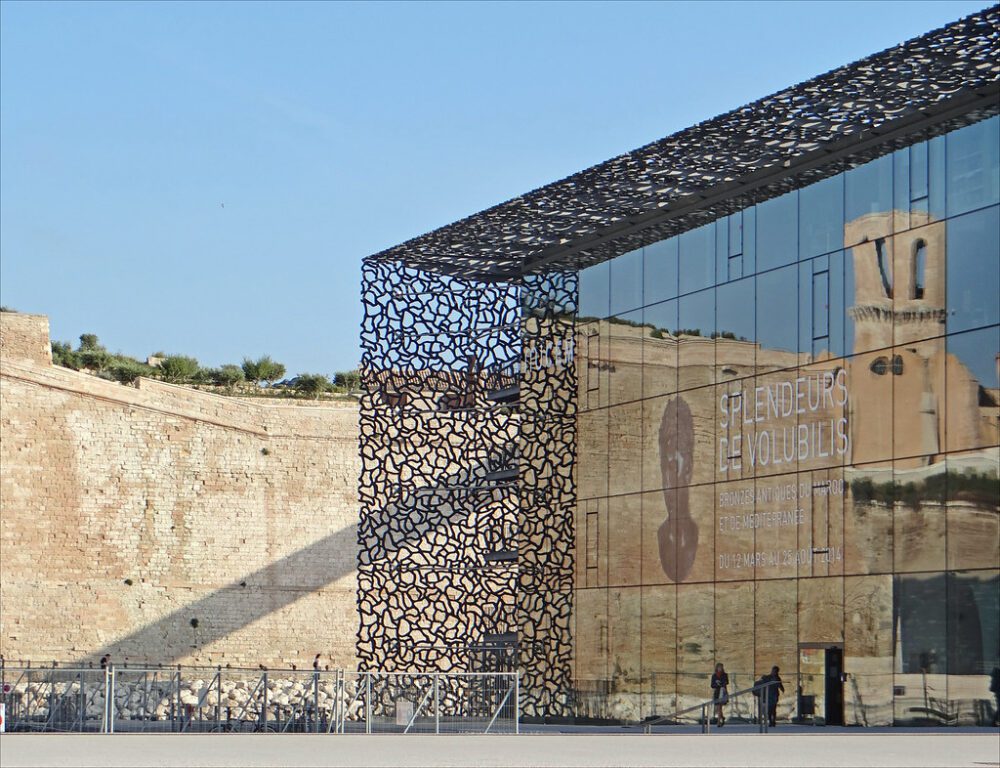
The Museum of European and Mediterranean Civilisations (MuCEM) is a cultural landmark situated in Marseille, France, at the entrance of the Old Port. Established in 2013 as part of Marseille’s designation as the European Capital of Culture, MuCEM was designed by architect Rudy Ricciotti and showcases the rich heritage of European and Mediterranean civilizations. The museum’s striking architecture, characterized by a latticed concrete facade that allows natural light to filter through, blends modern design with traditional Mediterranean influences, offering visitors a captivating visual experience even before entering the exhibitions. Visitors should plan their visit to MuCEM carefully, as the museum’s extensive collection and diverse exhibitions can easily fill several hours of exploration.
Inside MuCEM, visitors are invited to delve into the interconnected history, art, and cultures of Europe and the Mediterranean region through thought-provoking exhibitions and displays. The museum’s permanent collection features a wide range of artefacts, artworks, and multimedia installations that explore themes such as migration, trade, and cultural exchange. From ancient relics to contemporary creations, MuCEM offers insights into the shared heritage and diverse identities of the Mediterranean world. Additionally, the museum’s rooftop terrace provides panoramic views of the Old Port and the Mediterranean Sea, making it an ideal spot to pause and admire Marseille’s stunning waterfront scenery.
Fort Saint-Jean
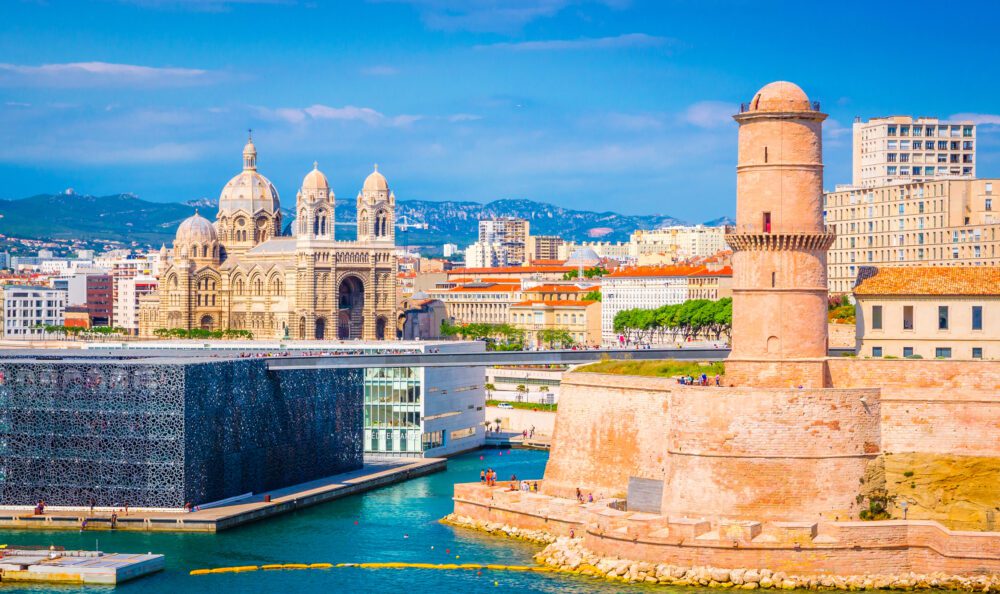
Fort Saint-Jean is a historic military fortress located at the entrance of the Old Port of Marseille, overlooking the Mediterranean Sea. Dating back to the 12th century, the fort has played a significant role in the defense of Marseille throughout its tumultuous history. Originally constructed by the Knights Hospitaller as part of the city’s fortifications, Fort Saint-Jean has undergone several expansions and renovations over the centuries, with its current form largely shaped by the military engineer Vauban in the 17th century. Today, the fort serves as a cultural landmark and museum, offering visitors the opportunity to explore its storied past and enjoy panoramic views of Marseille and the coastline beyond. Visitors should wear comfortable walking shoes as exploring the fort involves navigating uneven terrain and steep staircases.
Upon entering Fort Saint-Jean, visitors are greeted by a blend of ancient architecture and modern design. The fort’s interior houses a range of exhibitions and cultural spaces, including the Museum of European and Mediterranean Civilisations (MuCEM) extension, which connects Fort Saint-Jean to the neighbouring J4 building via a striking footbridge. Exhibitions within the fort explore themes such as maritime history, Mediterranean culture, and the fort’s own military heritage. Additionally, the fort’s expansive outdoor spaces, including its courtyards and ramparts, provide opportunities for strolls and breathtaking views of Marseille’s coastline.
Palais Longchamp
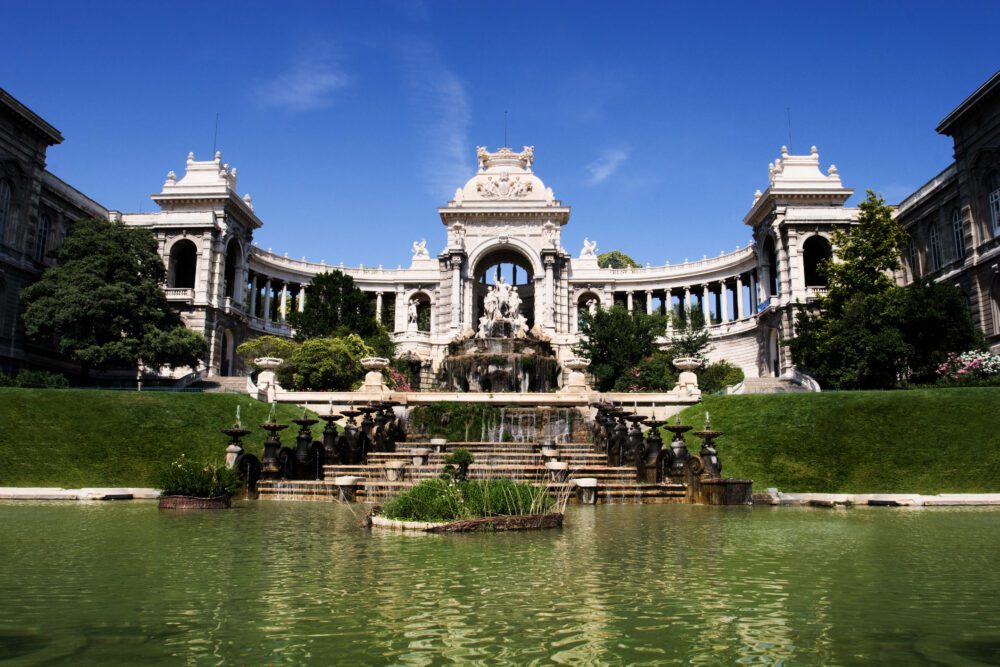
Palais Longchamp is a grand architectural complex located in the heart of Marseille, renowned for its neoclassical design and historical significance. Built in the 19th century, the palace was commissioned by Napoleon III as a monument to celebrate the construction of the Canal de Marseille and the Canal de Provence, which provided the city with a reliable water supply. Designed by the architect Henri-Jacques Espérandieu, Palais Longchamp is a masterpiece of monumental architecture, featuring a majestic collonaded façade adorned with sculptural reliefs and ornate detailing. The centrepiece of the complex is the grand fountain, which cascades water down a series of cascades and basins, symbolizing the abundance of water brought to the city. Visitors should allocate ample time to explore the palace grounds and its surrounding park, as there are plenty of photo opportunities and tranquil spots to relax.
Today, Palais Longchamp houses two major cultural institutions: the Museum of Fine Arts and the Museum of Natural History. The Museum of Fine Arts boasts a diverse collection of artworks spanning various periods and styles, including paintings, sculptures, and decorative arts. Visitors can admire masterpieces by renowned artists such as Rubens, Van Gogh, and Monet, as well as discover works by local Provencal artists. Meanwhile, the Museum of Natural History showcases an extensive range of exhibits related to natural history, geology, and ethnography, offering insight into the region’s flora, fauna, and cultural heritage. In addition to its museums, Palais Longchamp is surrounded by expansive parkland, making it an ideal destination for leisurely walks, picnics, and outdoor activities.
Frioul Archipelago and Chateau d’If

The Frioul Archipelago, located just off the coast of Marseille, is a stunning collection of four islands: Pomègues, Ratonneau, If, and Tiboulen. Among these, Château d’If stands out as a historic fortress with a rich and intriguing past. Constructed in the 16th century by King Francis I, Château d’If served primarily as a defensive stronghold to protect the city of Marseille from naval attacks. Over the centuries, it gained notoriety as a state prison, most famously depicted in Alexandre Dumas’ novel “The Count of Monte Cristo.” Visitors can take a short ferry ride from Marseille’s Old Port to reach Château d’If and explore its well-preserved ramparts, dungeons, and panoramic views of the Mediterranean Sea.
Today, Château d’If is a popular tourist destination, offering guided tours that delve into its fascinating history and literary connections. Visitors can wander through the fortress’s labyrinthine corridors, visit the cells where prisoners were once held captive, and learn about the daring escapes and dramatic events that have unfolded within its walls. Additionally, the Frioul Archipelago provides opportunities for outdoor activities such as hiking, swimming, and snorkelling, allowing visitors to immerse themselves in the natural beauty of the Mediterranean coastline. With its captivating history, stunning scenery, and cultural significance, the Frioul Archipelago and Château d’If offer a memorable experience for travellers exploring the vibrant city of Marseille.
Notre Dame de la Garde Basilica

Perched atop the highest point in Marseille, Notre-Dame de la Garde Basilica, affectionately known as “La Bonne Mère” (The Good Mother), is an iconic symbol of the city. Built between 1853 and 1864 in a Neo-Byzantine style, the basilica boasts a striking exterior adorned with intricate mosaics and a majestic golden statue of the Virgin Mary standing atop its bell tower. The site holds deep religious significance for locals, who have long revered Notre-Dame de la Garde as their protector and patroness. Visitors can ascend to the basilica by foot, following a scenic climb up the hillside, or opt for a convenient shuttle or tourist train from the Old Port. Once at the top, they are rewarded with breathtaking panoramic views of Marseille and its picturesque coastline.
Inside the basilica, visitors can admire its opulent interior, which features stunning stained glass windows, ornate altars, and ex-votos left by devotees as tokens of gratitude for answered prayers. The basilica also houses a small museum showcasing maritime artefacts and historical objects related to Marseille’s maritime heritage. Practical tip: While visiting Notre Dame de la Garde, be sure to arrive early to avoid crowds and take advantage of the quieter atmosphere for contemplation and reflection. Additionally, consider timing your visit to coincide with sunset for a truly unforgettable experience, as the basilica offers some of the most spectacular sunset views in Marseille, with the city bathed in golden light against the backdrop of the Mediterranean Sea.
Abbey of Saint Victor

Founded in the 5th century, the Abbey of Saint Victor stands as one of Marseille’s oldest religious sites, steeped in centuries of history and spirituality. Originally established as a monastery dedicated to Saint Victor of Marseille, the abbey grew over time to become a prominent centre of learning and religious scholarship in the region. Its strategic location near the Vieux Port made it a vital hub for maritime travellers and pilgrims journeying to and from the Holy Land during the Middle Ages. Today, visitors to the abbey can explore its ancient crypt, which dates back to the 11th century and is renowned for its intricate stone carvings and eerie ambience. The crypt also houses the relics of Saint Victor, attracting pilgrims and religious devotees seeking spiritual solace.
When visiting the Abbey of Saint Victor, take time to wander through its tranquil cloisters, adorned with fragrant orange trees and serene garden spaces. Guided tours are available for those interested in delving deeper into the abbey’s rich history and architectural significance. Additionally, don’t miss the opportunity to attend a religious service or concert at the abbey, where the sacred music and spiritual atmosphere create a profound sense of reverence and contemplation.
Palais du Pharo
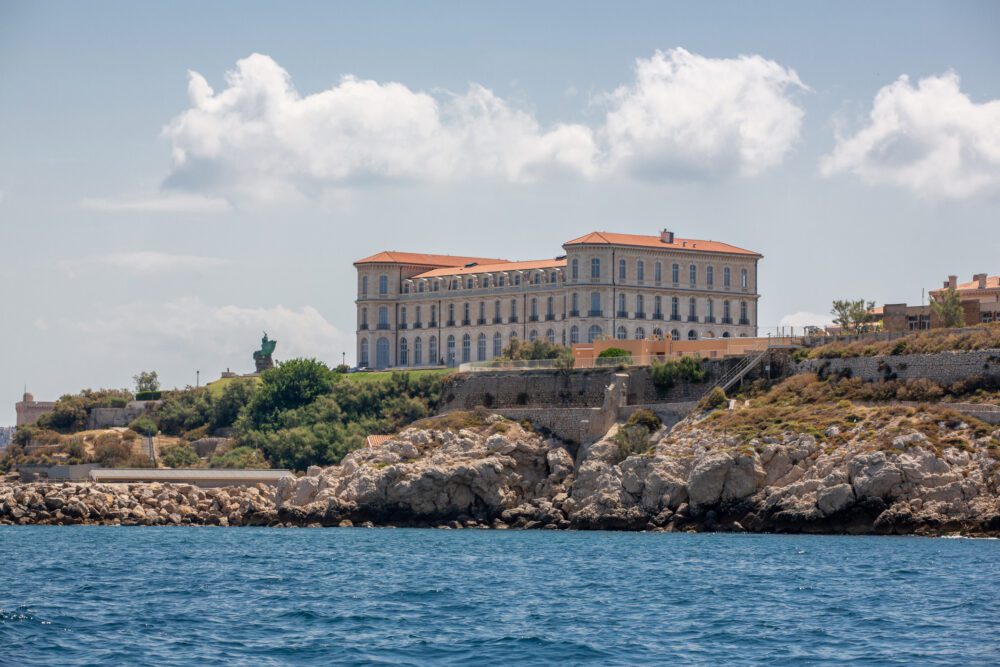
Perched on a rocky promontory overlooking Marseille’s Vieux Port, the Palais du Pharo exudes grandeur and elegance. Built in the mid-19th century by Emperor Napoleon III for his wife, Empress Eugénie, the palace was intended as a lavish residence and a symbol of imperial power. Its design, inspired by the Italian Renaissance style, features imposing facades, ornate balconies, and sweeping staircases, all overlooking the sparkling waters of the Mediterranean Sea. Today, the Palais du Pharo serves as a prestigious conference centre and venue for cultural events, conferences, and exhibitions. Its stunning waterfront location makes it a popular spot for locals and visitors alike to stroll along the promenade and enjoy panoramic views of the harbour and city skyline.
While the interior of the Palais du Pharo is typically reserved for private events and conferences, visitors can still admire its splendid architecture from the outside. Take a stroll along the Quai du Port to enjoy unobstructed views of the palace and its picturesque surroundings. Consider visiting during the golden hour to witness the palace bathed in the warm hues of the setting sun, creating a truly magical atmosphere. Additionally, the nearby Jardin du Pharo offers a peaceful retreat where visitors can relax amid lush greenery and enjoy breathtaking vistas of the Mediterranean coastline.
Vallon des Auffes

Nestled between limestone cliffs and the azure waters of the Mediterranean Sea, Vallon des Auffes is a charming fishing village that offers a glimpse into Marseille’s maritime heritage. Dating back to the 17th century, this picturesque harbour was once a bustling fishing port and hub for local fishermen. Today, it retains much of its traditional charm, with colourful fishing boats bobbing in the harbour and quaint fisherman’s cottages lining the waterfront. Visitors can wander along the narrow cobblestone streets, soak in the tranquil atmosphere, and watch as fishermen go about their daily routines. The iconic Vallon des Auffes bridge, spanning the entrance to the harbour, provides stunning panoramic views of the coastline and is a favourite spot for photographers and sightseers.
To fully experience the charm of Vallon des Auffes, consider dining at one of the waterfront restaurants that dot the harbour. Here, you can savour freshly caught seafood dishes while enjoying the serene ambience and panoramic views of the Mediterranean Sea. For a truly authentic experience, visit in the early morning to witness the fishermen returning with their daily catch or in the evening to admire the sunset casting a golden glow over the harbour. Additionally, Vallon des Auffes is a popular swimming spot for locals during the warmer months, with rocky ledges providing access to the crystal-clear waters below
Marseille Beaches
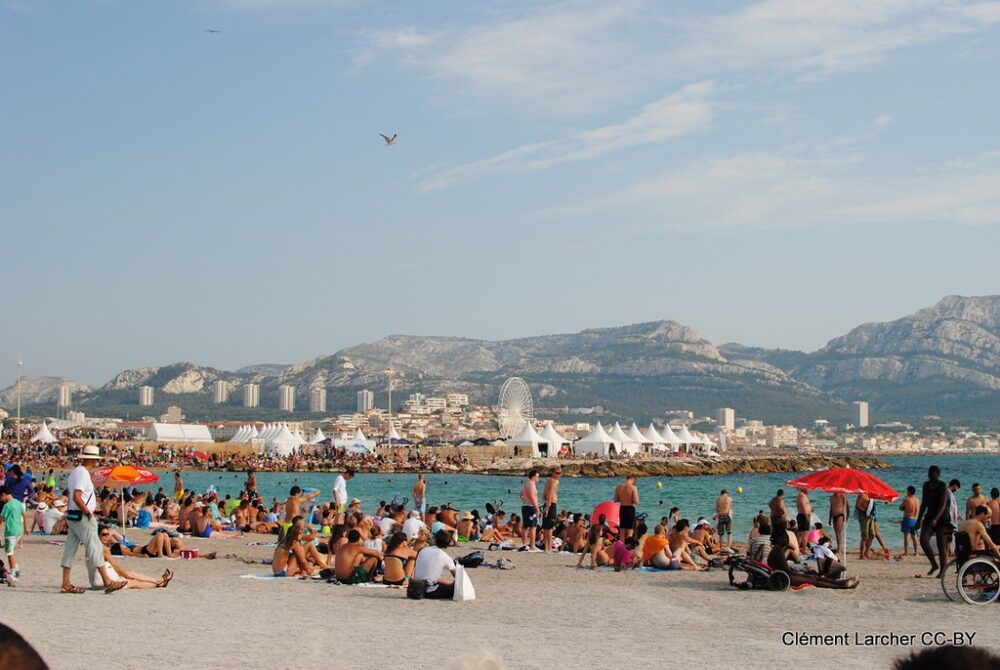
Marseille boasts a collection of stunning beaches along its coastline, each offering its own unique charm and atmosphere. One of the most popular beaches is Plage du Prado, a wide stretch of golden sand located near the city centre. Originally developed in the 1970s, Plage du Prado has since become a beloved destination for both locals and tourists seeking sun, sea, and relaxation. With its clear waters and well-maintained facilities, including showers, lifeguard stations, and beachside cafes, it’s the perfect spot for a day of sunbathing and swimming. For those seeking a more secluded escape, the Calanques, a series of rugged coastal coves located to the south of the city, offer pristine beaches nestled between towering limestone cliffs. Accessible by boat or on foot, these idyllic spots are ideal for snorkelling, hiking, and picnicking amidst breathtaking natural scenery.
When visiting Marseille’s beaches, it’s important to come prepared with sunscreen, hats, and plenty of water, especially during the summer months when temperatures can soar. Additionally, some beaches may have pebbly or rocky terrain, so wearing appropriate footwear is recommended. For those looking to escape the crowds, consider visiting the beaches early in the morning or later in the evening when they are less busy. Lastly, be sure to respect the natural environment and follow any posted guidelines to help preserve these beautiful coastal areas for future generations to enjoy. Whether you’re seeking relaxation, adventure, or simply a taste of the Mediterranean lifestyle, Marseille’s beaches offer something for everyone to enjoy.
Parc Borély
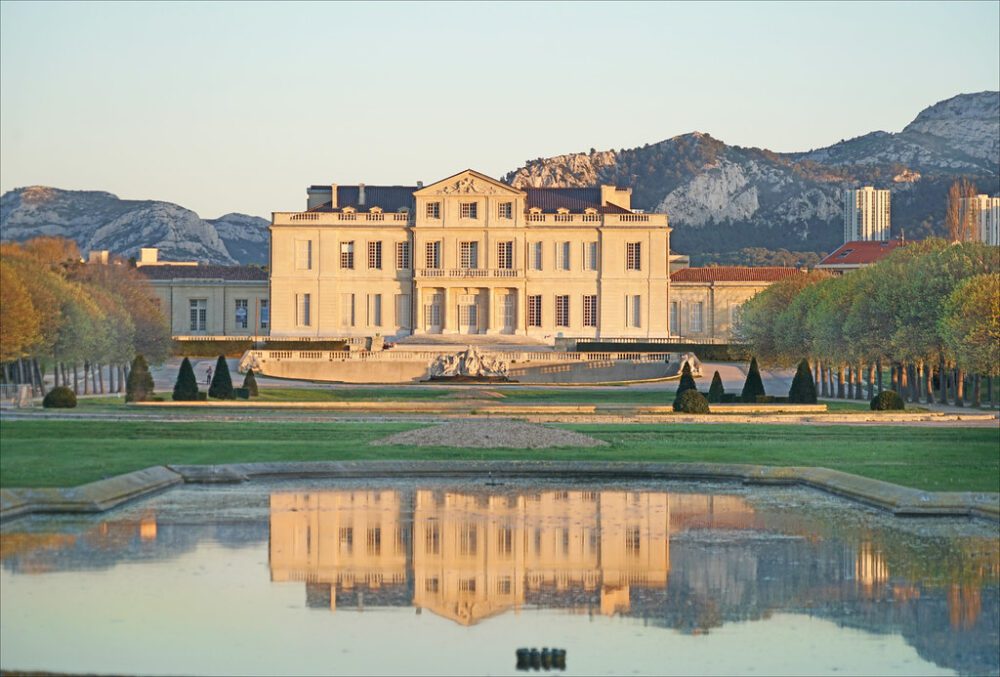
Parc Borély, situated in the southern part of Marseille, is a verdant oasis that spans over 17 hectares along the Mediterranean coast. It is one of the city’s largest and most picturesque parks, offering visitors a tranquil escape from the bustling urban environment. Originally designed in the 18th century, the park underwent significant renovations in the 19th century under the direction of landscape architect Adolphe Alphand, who transformed it into a formal French garden with lush lawns, ornamental flowerbeds, and serene water features. Today, Parc Borély is a popular destination for locals and tourists alike, offering a range of recreational activities and attractions. Visitors can stroll along tree-lined pathways, relax in shaded groves, or enjoy a leisurely picnic amidst the park’s scenic surroundings. The park also features a botanical garden with a diverse collection of plant species, as well as a charming rose garden that blooms in vibrant colours during the spring and summer months.
When visiting Parc Borély, consider bringing along a picnic basket filled with delicious French delicacies to enjoy al fresco dining in one of the park’s many scenic spots. Don’t forget to pack a blanket or portable chairs for added comfort. Additionally, the park is home to several playgrounds, making it an ideal destination for families with children. For those looking to stay active, Parc Borély offers opportunities for jogging, cycling, and rollerblading along its paved pathways. The park also hosts various cultural events and outdoor concerts throughout the year, providing visitors with the chance to experience Marseille’s vibrant arts scene in a beautiful natural setting.
Calanques National Park

Calanques National Park, located just south of Marseille, is a breathtaking natural reserve known for its rugged limestone cliffs, crystal-clear turquoise waters, and pristine Mediterranean landscapes. Spanning over 520 square kilometres, the park encompasses a diverse range of ecosystems, including coastal cliffs, hidden coves, and dense pine forests. The word “calanque” refers to narrow, steep-walled inlets formed by the erosion of limestone rocks over millions of years, creating a stunningly dramatic coastline that is unique to this region. The park’s rich biodiversity makes it a haven for wildlife, with numerous species of birds, marine life, and rare plants thriving in its protected habitats. Calanques National Park also holds significant cultural and historical value, with evidence of human habitation dating back thousands of years. Visitors to the park can explore ancient archaeological sites, discover hidden caves and grottoes, and marvel at the stunning geological formations that have been sculpted by the forces of nature.
Due to its rugged terrain and remote location, accessing Calanques National Park requires careful planning and preparation. It is recommended to wear sturdy hiking shoes and bring plenty of water, sunscreen, and snacks, as well as a map or GPS device to navigate the park’s extensive trail network. Visitors can choose from a variety of hiking routes ranging from easy coastal paths to more challenging climbs, each offering spectacular views of the Mediterranean coastline. Swimming and snorkelling are popular activities in the park, with numerous secluded beaches and pristine coves accessible by boat or on foot. For those looking to explore the park’s marine life, guided boat tours and kayak excursions are available, providing a unique opportunity to discover hidden sea caves and underwater ecosystems.
Conclusion
Marseille offers a diverse range of attractions and experiences that appeal to travellers of all interests. From its vibrant old port to its rich cultural heritage, there is no shortage of things to see and do in this dynamic city. Visitors can immerse themselves in the city’s fascinating history, explore its stunning natural landscapes, indulge in delicious cuisine, and relax on its picturesque beaches. Whether you’re wandering through the historic streets of Le Panier, admiring the breathtaking views from Notre Dame de la Garde, or hiking along the rugged coastline of Calanques National Park, Marseille captivates with its unique charm and allure.
With its blend of ancient history, vibrant culture, and natural beauty, Marseille offers a truly unforgettable travel experience. Whether you’re a history buff, an outdoor enthusiast, or a food lover, this cosmopolitan city has something to offer everyone. From its bustling markets and lively waterfront to its charming neighbourhoods and stunning coastal scenery, Marseille is a destination that will leave a lasting impression on all who visit.
